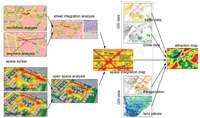Computational Landscape: Data Driven Urban Modeling with Agent-based System

The paper describes the process of bottom-up design and simulation to generate emergent urban patterns and adaptive urban forms. Starting with movement simulation, agent-based modeling tools are used to decode and recode the spatial complexity within the parametric equation. Computational tools for architects and urban designers such as a minimum path algorithm, spatial accessibility analysis, GIS, and procedural modeling are integrated to build a platform that allows parametric control of the generative outcome. The authors focus on how agent-driven emergent patterns can evolve during the simulation in response to globalized goals.
keywords: Self-Organizing, Agent-Based System, Space Syntax, Bottom-Up, Emergent


Add comment
Log in to post comments